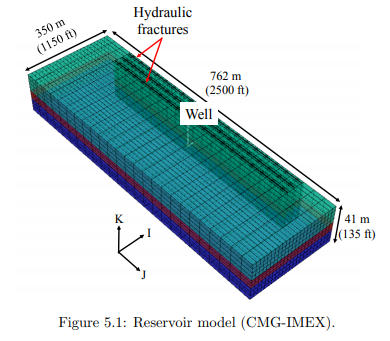Shale Reservoir Simulation in Basins with High Pore Pressure and Small Differential Stress
Abstract
Hydrocarbon production from mudrock (“shale”) reservoirs is fundamental in the global energy supply. Extracting commercial amounts of hydrocarbons from shale plays requires a combination of horizontal well drilling, hydraulic fracturing, and multi-stage completions. This technology creates conductive hydrofractures that may interact with pre-existing natural fractures and bedding planes. Microseismic studies and field pilots have uncovered evidence of complex hydrofracture geometries that can lead to unsatisfactory wellbore flow performance. This study examines the effects of three hydrofracture geometries (”scenarios”) on wellbore production in overpressured shale oil reservoirs using a commercial reservoir simulator (CMG IMEX). The first scenario is our reference case. It comprises ideal ized and vertical hydrofractures. The second scenario has an orthogonal hydrofracture network made up of vertical hydrofractures with perpendicular secondary fractures. The third scenario has vertical hydrofractures with horizontal bedding plane frac tures. We generated additional simulation models that aim to capture the effect on hydrocarbon production of different fracture properties, such as natural fracture ori entation and spacing, number of hydrofractures per stage, number of perpendicular secondary fractures and horizontal fractures, and fracture closure mechanism. The results show that ideal planar fractures are an oversimplification of the hydrofracture geometry in anisotropic shale plays. They fail to represent the complex geometry in reservoir simulation and lead to unexpected hydrocarbon production forecasting.
They also show that the generation of unpropped horizontal fractures harms hydro carbon productivity, while perpendicular secondary fractures enhance initial reservoir fluid production. The generation of horizontal hydrofractures is a particular scenario that may occur in reservoirs with high pore pressure and transitional strike-slip to reverse faulting regime. These conditions have been reported in unconventional source rock plays, like the Marcellus shale in northeast Pennsylvania and southwest Virginia, and the Tuwaiq Mountain formation in the Jafurah Basin in Saudi Arabia. Our findings reveal that the presence of horizontal hydrofractures might reduce the cumulative hydrocarbon production by 20%, and the initial hydrocarbon production by 55% compared to the reference case. Our work shows unique reservoir simulations that enable us to assess the impact of different variables on wellbore production performance and understand the effects of varied hydrofracture geometries on hydrocarbon production.


